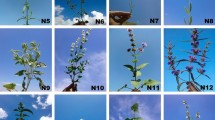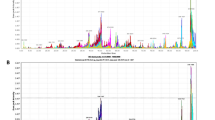Abstract
CHROMATOGRAPHIC and spectrophotometric properties of ellagic acid have now been investigated in order to facilitate the identification of this acid in plant extracts and hydrolysates. In early studies, ellagic acid has not always been adequately characterized; but the present work has confirmed the occurrence of this substance in a wide range of dicotyledonous plants1. Ellagic acid has also been identified in Terminalia arjuna, bellirica, citrina, pallida and travencoriensis for the first time.
This is a preview of subscription content, access via your institution
Access options
Subscribe to this journal
Receive 51 print issues and online access
$199.00 per year
only $3.90 per issue
Buy this article
- Purchase on Springer Link
- Instant access to full article PDF
Prices may be subject to local taxes which are calculated during checkout
Similar content being viewed by others
References
Wehmer, C., and Hadders, M., in Klein, “Handbuch der Pflanzen-analyse”, 3, pt. 1, 407 (Springer-Verlag, Vienna, 1932).
Hathway, D. E., Biochem. J. (in the press).
Grove, J. F., and Willis, H. A., J. Chem. Soc., 877 (1951).
Flett, M. St. C., J. Chem. Soc., 962 (1951).
Schmidt, O. T., Voigt, H., and Bernauer, K., Chem. Ber., 88, 91 (1955).
Perkin, A. G., J. Chem. Soc., 87, 1412 (1905).
Author information
Authors and Affiliations
Rights and permissions
About this article
Cite this article
HATHWAY, D. Chromatographic and Spectroscopic Properties of Ellagic Acid, and its Occurrence in Dicotyledonous Plants. Nature 177, 747–748 (1956). https://doi.org/10.1038/177747a0
Issue Date:
DOI: https://doi.org/10.1038/177747a0
This article is cited by
-
Ellagic acid fromEuphorbia petrophila andE. iberica
Chemistry of Natural Compounds (1969)
-
Partition chromatography and its use in the plant sciences
The Botanical Review (1959)
Comments
By submitting a comment you agree to abide by our Terms and Community Guidelines. If you find something abusive or that does not comply with our terms or guidelines please flag it as inappropriate.



